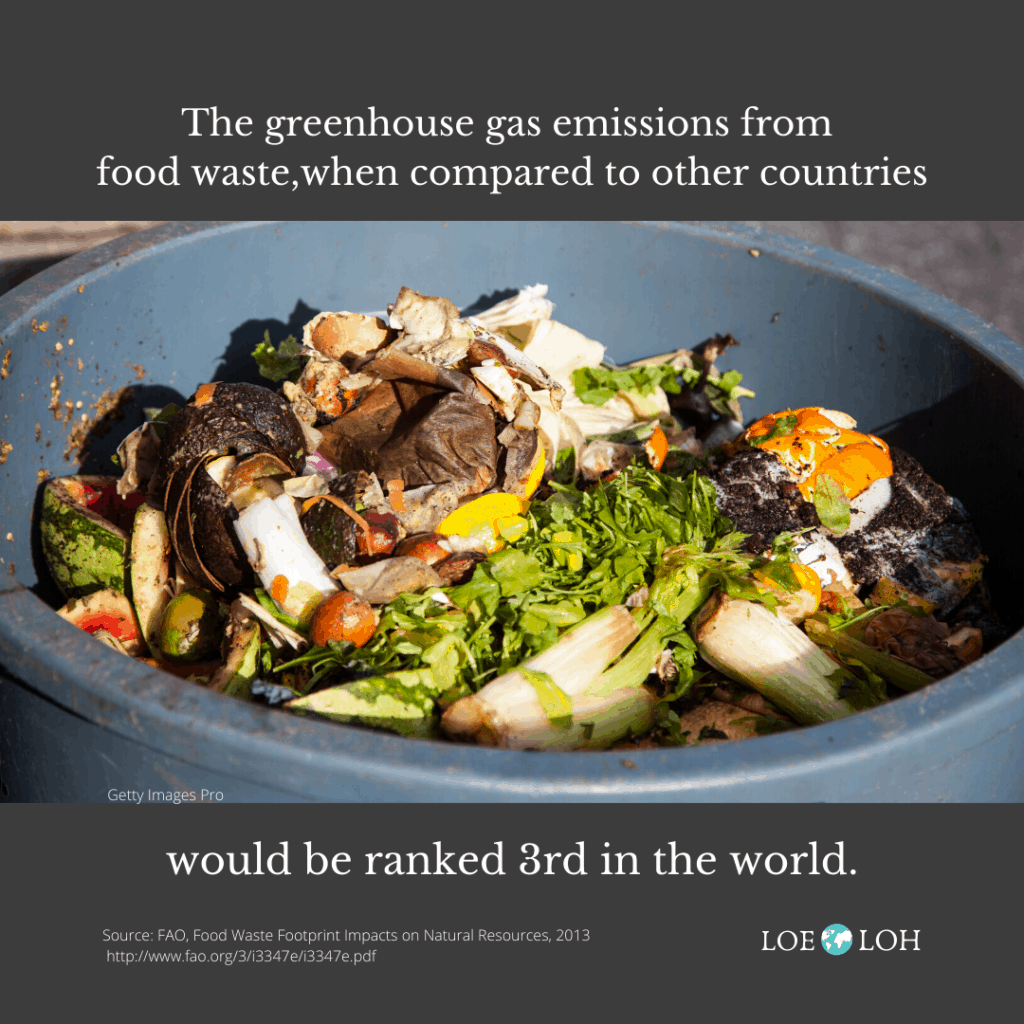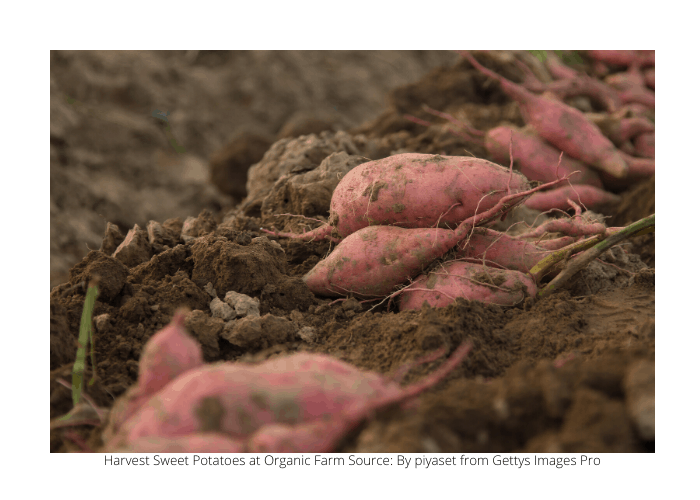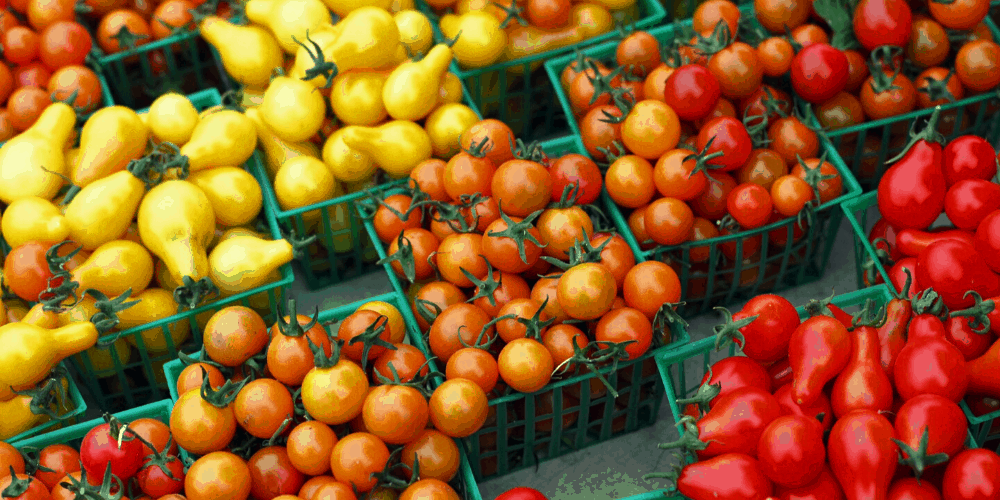Why is reducing food waste important?

Global food waste is the 3rd highest greenhouse gas emitter in the world when compared with other countries’ total emissions as found by the Food Wastage Footprint project at Food and Agriculture Organization of the United Nations (FAO). About one third of the food produced worldwide is wasted which costs about 1 trillion US dollars every year. (1, 2)
Food Waste from Farm to Table
It takes a lot of energy, fertilizer, water, and land resources to get our food from the farm to our table. The steps of Food Supply Chain are: agricultural production, postharvest handling and storage, processing, distribution, consumption, and end of life. Each of these steps emits greenhouse gases like carbon dioxide, methane, and nitrous oxide. (1)
Methane and nitrous oxide are significant greenhouse gases. Methane is 25 times stronger than carbon dioxide and nitrous oxide is 298 times stronger than carbon dioxide in their greenhouse effect. They are included in carbon footprint calculations as carbon dioxide equivalents or CO2eq. (1)
Different food groups have unique carbon footprints. The production of foods that emit more methane and nitrous oxide increase the carbon footprint of these foods substantially. For example, meat from cows has a higher carbon footprint than meat from chickens because cows emit methane from their stomachs when they burp. FAO also noted that of the cereals food group, (wheat, oats, barley, rice, etc), rice especially has a higher carbon footprint because of the methane emitted from the rice paddies and the nitrogen fertilizers used for farming. (1)
The carbon footprint of food can emit even more emissions at the last step of the food supply chain called end of life. Food’s end of life is when food is wasted. Food can be wasted at any of the food production steps. Depending on the conditions of where the food is wasted, there is potential for even more emissions. In conditions without oxygen, like in landfills, the bacteria that breakdown food and other organic material release methane. (1)
When food reaches us, the consumer, the carbon footprint of food is nearly at its peak. This is because the carbon dioxide and other greenhouse gas emissions have accumulated from the various food production steps prior to the final food product reaching us. Unfortunately, in higher income regions, up to 35% of food waste occurs at the consumer stage. (1, 3)
Food waste throws away Water, Land, and Needed Meals
Global food waste also includes the water and land used to grow and process the food. The amount of water wasted, is more water than any one country uses for agricultural purposes. Wasted food also used up 1.4 billion hectares of land in 2007. This is enough land mass to cover more than Canada or China! (1)
Last but certainly not least, by addressing food waste, we can also address food insecurity. Again, almost one third of the food produced globally is wasted. FAO calculated that of the 1.6 Gigatons of food wasted, 1.3 Gigatons of the wasted food was edible. There are around 821 million people globally who are undernourished. In the US alone there are 40 million who are food insecure. France and Italy have already seized the opportunity of reducing food waste and addressing food insecurity. In 2016, France passed a law that requires grocery stores to donate their food to charity or they are charged fines. Italy in 2016 also passed a law supporting businesses to donate food to charity while decreasing the taxes for the business as they give more. (1, 4, 5, 6, 7, 8)
Reduce food waste & reduce carbon dioxide emissions
This information reinforces why reduced food waste is ranked in the top 3 solutions of both scenarios from Project Drawdown’s climate change solutions. Project Drawdown calculated that reducing food waste could keep an estimated 87.45-94.56 gigatons of carbon dioxide equivalents from being emitted over the next 30 years. (3)
The complex issues of reducing food waste and carbon dioxide emissions have some similarities. By addressing both we are able to help massive numbers of people. There are numerous solutions available today to make progress on both. We have to do this together. Who is ready and willing to reduce all the food waste?!
Reduce Food Waste In Your Community
Gleaning

Uh, you spelled “cleaning” wrong. Haha, It is true, I have a tendency to misspell. However, gleaning I did spell correctly. (fist pump) Gleaning is harvesting produce that was left on the fields by farmers. There are several reasons food is left on fields, one is the aesthetic quality of the produce is not up to certain standards, or the farm produced too much food.
The FAO learned that farmers leave almost 50 percent of their yield on the field to be ploughed back into the land. Fortunately, there are examples across the globe of gleaning go getters. Does your company or organization like to get involved in the community? Do you live in area with farms close by? Gleaning is great way to volunteer and reduce food waste.
Feedback
Feedback is a global organization working towards improving the entire food system. Their work has brought them all around the world including Europe, North America, South America, Africa, and Australia. Feedback was co-founded by Tristram Stuart who has written a book called Waste: Uncovering the Global Food Scandal and started an event called Feeding the 5000. These events are communal feasts that feed 5000 people with food that would have otherwise been wasted. Feedback also has a Gleaning Toolkit available to help you get a Gleaning Group set up in your community today!
Food Forward
Based in California, Food Forward’s team has rescued over 90 million pounds of food. On their website they provide information of gleaning groups around the U.S.
Society of St. Andrew’s
Society of St. Andrew’s was established in 1979. In 2019 alone they saved over 13 million pounds of food from being wasted. Currently they have locations in southeast and midwestern regions of the US.
Connect Businesses to Non-Profits
Are you in the food industry, or do you know someone who is? Are you involved in local non-profit organizations? The following companies use technology to connect food surplus from local businesses to local charities and organizations.
Goodr
Goodr is a tech company started by Jasmine Crowe in 2017. She realized to feed those in need and to waste less food she needed to provide a service that resolves the logistics of connecting the two issues. So Jasmine developed the Goodr app. The app provides businesses the ability to track their food surplus and connect to local organizations and charities that feed people who are food insecure. Goodr arranges food pick-ups after hours for businesses. With Goodr businesses can save money, provide tax deductible products, waste less food, and feed the hungry people of their community. They have saved 2 million pounds of food and with this food provided 1.7 million meals to people in need. Learn more about Goodr and Jasmine Crowe from her awesome TED talk.
Copia
Copia is similar to Goodr. It is an app that businesses in the food industry can use to connect to local non-profits. Copia also pick-ups the food and provides information on tax deductions for businesses.
Food Cowboy
Food Cowboy is another app that connects food companies, distributors, event hosts with charities. A strength of this group is aiding in relocation of unwanted food items to local charities.
Support your Local Farmers Markets
Supporting your local farmers markets has multiple benefits. It decreases the steps of the Food Supply Chain by consumers, like us, purchasing straight from the farmer. This results in less greenhouse gases by skipping the usual steps it takes to get the food from the farm to our home. Also, the produce in the farmers market provides an opportunity for fruits and vegetables that may not meet supermarket standards to be sold. Finally, farmers markets can provide an avenue for other carbon reducing initiatives like composting and zero-waste. The Boulder County Farmers Markets since 2005 has made their farmers markets zero-waste events with compost bins, recycling bins, and no trash bins. (10)
Get your local schools involved
A study back in 2013 estimated that over $1.2 billion US dollars worth of food is wasted every school year. Both the USDA and No Kid Hungry have resources to get schools started on reducing food. (11)
Food Matters Action Kit
Food Matters Action Kit is a free toolkit to teach kids about food waste. It was created by the Commission for Environmental Cooperation a group formed by the governments of Canada, Mexico, and United States.
Best By Dates
Refed is a US based organization working on several initiatives to reduce food waste. One of these initiatives is advocating for policies to standardize best by, sell by, and other dates on food labels. As the dates creates a lot of confusion among consumers and businesses leading to edible food being wasted. Per the USDA, the food dates are provided to help us decide when the food is at its best quality. For more details on food date labels check out the USDA’s website. (12)
Reduce Food Waste At Home
Grocery Shopping

Shop from Home First I don’t mean online shopping. I mean look at what food you already have in your fridge, freezer, and pantry and eat it all up. (9)
Menu Plan Start with the food you have at home in your fridge and cupboard. Plan out your menu and then make your shopping list on what is still needed. (9)
Plan your shopping list And stick with it! Try not to buy more of the discounted food deals than needed. This avoids having too much food at home and the potential for food waste. (9)
Shop when you are NOT hungry Who has gone to the grocery store hungry and come home with one too many bag of potato chips? ME! I am sure I am not alone. Keep a snack on hand or try to plan your shopping trips when you are not hungry.
Shop in the morning We tend to make less impulsive decisions in the morning.
Say Yes to Ugly: Don’t fret over the bruised produce in the store, take it home and make it delicious. Sometimes stores have a reduced price produce section for the not so appealing (get it 😉) goods. If the ugly produce is in your home, cook with it. See if there is a recipe at Savethefood.com. They provide recipes for different foods that are past their prime. (9)
Buy the amount you need and regularly consumed I have accepted that green leafy salads are not my soul food, especially in the winter. If I get a plastic container full of greens, some of those vibrant greens will likely turn mushy. Buy groceries in the amount you will eat. For myself, instead of purchasing a large plastic container of spinach, I have started to buy smaller bunches of spinach. Extra kudos because this reduces single use plastics. (9)
Storing Your Food
FIFO FIFO stands for “First In, First Out.” This is a technique used in biotech industry to ensure older stock or supplies are used first. FIFO can easily be applied to food at home. When you get home from the grocery store, shift the older foods in your fridge or pantry to the front and put your new purchases behind them to make sure older foods are eaten first. (9)
Store food appropriately Recently, I learned that tomatoes are best stored on the counter top, NOT the crisper. Whoops. Whole wheat flour should be stored in either the refrigerator or freezer then brought to room temp prior to use. (13) Other food storage questions, check out savethefood.com for additional details of best ways to store foods. Savethefood.com is website provided by the Natural Resources Defense Council and Ad Council to decrease food waste.
Store your grains in sturdy containers I learned the hard way when we allowed a party of weevils to flourish in a bag of rice. Weevils and other grain happy bugs are like us, just trying to eat and provide for the next generation. Weevils are a naturally occurring insect in grains. The eggs of weevils are not usually noticeable to our naked human eye but the adult versions definitely are. They also have pretty impressive jaw strength. They can eat themselves out of one bag and right into another. Yeah, not a fun day in the pantry. So, take it from me, please store all of your grains, rice, flour, oatmeal, pasta, quinoa etc. in sturdy food friendly plastic or glass containers. In order, to prevent any weevils to move through your home like a buffet and reduce food waste. 😊
Food storage containers and a good rubber spatula These two kitchen items I use regularly to store my leftovers and to scrape every last morsel from my plate or pan into a container. Use the storage containers you have. However, if you would like to upgrade your food containers first DONATE your older ones to a local thrift store.
REUSE Instead of buying all new food storage food containers, reuse food storage containers from empty glass spaghetti or jam jars. Extra kudos for upcycling.
FREEZE
IT!
Often before a trip or a long weekend away from home I find that I have a green
pepper, zucchini or tomatoes staring up at me from the crisper. I will chop
these veggies or fruit and then freeze them. Do note that NOT all produce take
well to freezing, like potatoes. Check outsavethefood.com for more
details. For the produce that can withstand the cold, frozen veggies make for
some yummy soups and frozen fruits are delightful for cobblers or fancy
parfaits. Also FREEZE your leftovers. Are you tired of day 3 of chili?
Store your leftovers in the freezer to save it for the next chilly day. (9)
Clean Plate Club Now this one
does not mean eating every last morsel on your plate. I am a believer in
listening to our bodies and respecting that we don’t have to eat until we are
painfully full. Stop eating when your body is satisfied and save the
leftovers! Bring it to work the next day for lunch or get creative and cook
something new with your leftovers. (9)
Eating Out
Eating
out, save all the FOOD If
you are like me and generally do not finish your meal at a restaurant, bring
your leftovers home. Reduce single use containers by bringing your own
to-go containers and cups when going out to eat for leftovers. Please be
mindful and respectful that not all restaurants will be ok with using your own
to-go containers as it may be a safety concern for the restaurant.
California recently passed a law that restaurants can allow customers to use to
go containers but the restaurant has the right to refuse. (14)
Approach All You Can Eat Buffets Mindfully My
husband and I recently indulged at an all you can eat breakfast buffet and I am
hooked. But, similar to not shopping when you are hungry, be careful with
All You Can Eat Buffets. Maybe start with smaller portions of what you
think you may like and be mindful of your second or third plate. Do your
best to finish what you take from the buffet.
Compost
Compost If all else fails, then compost. Composting allows food scraps or food waste to decompose in an oxygen-rich environment and so methane is not produced. More good news about composting is it is fairly easy. Some challenges maybe initial costs, not having a backyard, and some general rules about composting. Stay tuned for a future post on composting. (9)
In conclusion, with over a dozen ways you and I can reduce our food waste at home, as well as the assortment of possibilities in our local communities, we can make big strides to reducing our food waste and reducing our carbon emissions. Let’s get at it!
Resources
1: Food Waste Footprint Impacts on Natural Resources Summary Report, FAO UN (2013). Retrieved from
http://www.fao.org/3/i3347e/i3347e.pdf
2: Food Waste Footprint Full-Cost Account Report Final Report, FAO UN (2014). Retrieved from http://www.fao.org/3/a-i3991e.pdf
3: Reduced Food Waste, Project Drawdown (2020). Retrieved from https://www.drawdown.org/solutions/reduced-food-waste
4: Max Roser and Hannah Ritchie (2020) – “Hunger and Undernourishment”. Published online at OurWorldInData.org. Retrieved from: ‘https://ourworldindata.org/hunger-and-undernourishment‘ [Online Resource]
5: FAO, IFAD, UNICEF, WFP and WHO. 2017. The State of Food Security and Nutrition in the World 2017. Building resilience for peace and food security. Rome, FAO. Available http://www.fao.org/3/I9553EN/i9553en.pdf
6: ReFED 2018 Annual Report. ReFED (2019) Retrieved from https://www.refed.com/downloads/ReFED_AnnualReport_2018.pdf?mc_cid=f67e28aa2e&mc_eid=ba48d84345&mc_cid=f67e28aa2e&mc_eid=ba48d84345&mc_cid=f67e28aa2e&mc_eid=ba48d84345
7: French Food Waste Law Changing How Grocery Stores Approach Excess Food, The Salt NPR. (2018 February 24). Retrieved from https://www.npr.org/sections/thesalt/2018/02/24/586579455/french-food-waste-law-changing-how-grocery-stores-approach-excess-food
8: Italy adopts new law to slash food waste, BBC News. (2016 August 03). Retrieved from https://www.bbc.com/news/world-europe-36965671
9: Toolkit Reducing the Food Wastage Footprint, FAO UN (2013) Retrieved from http://www.fao.org/3/i3342e/i3342e.pdf
10: Our Nonprofit, Boulder County Farmers Market, Retrieved from bcfm.org/our-non-profit/
11: Cohen, J. F., Richardson, S., Austin, S. B., Economos, C. D., & Rimm, E. B. (2013). School Lunch Waste Among Middle School Students. American Journal of Preventive Medicine, 44(2), 114–121. doi: 10.1016/j.amepre.2012.09.060
12: Standardized Date Labeling, ReFED. (2020) Retrieved from https://www.refed.com/solutions/standardized-date-labeling/
13: Flour, Whole Wheat, Save The Food Retrieved from https://savethefood.com/storage
14: California Sets Guidelines for Diners to Bring Their Own Containers to Restaurants, Food & Wine. (2019 July 19) Retrieved from https://www.foodandwine.com/news/california-bring-your-own-container-restaurant-law

